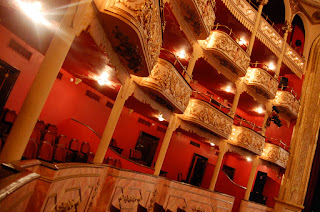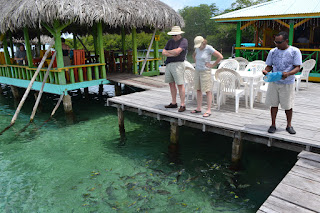September 10th
For the last
week and a half my parents and sister came to Panamá to visit me. It made me really happy to share a
little piece of my life in Panamá with them!
We spent the
first few days in Panamá City.
During our time there we had the opportunity to visit the Miraflores
locks on the Panamá Canal, walked around Panamá City’s historic district Casco Viejo, and went to some fun bars and
restaurants. They enjoyed their
time in the city and were impressed by how modern Panamá City is. If you just spent your time in the city
you would probably wonder why the Peace Corps are in Panamá.
Next we headed
to the Province of Coclé to visit my community, Piedras Gordas. When we arrived it was pouring outside
but that didn’t deter my 2nd host dad from proudly giving us a tour of his
home, my home, and the Cooperativa
Nazareno’s (the name of the environmental co-op) vivero (tree nursery), orchard of various fruit trees, plants used
to make artisan hats and crafts, and the Conejo
Pintados (large, delicious, endangered rodents…they look like large guinea
pigs). After the tour Katherine
played with the newborn puppies, we all drank coffee and shared stories,
impressions and experiences with one another. The next day we walked around the town, I showed my family
the school, church, a couple of the stores, and community buildings. During the tour we got roped into
visiting an elderly couple that for the last few months has been trying to
convince me to move into their guest house. Afterward we had a brinidis
(food, drinks, meet-and-greet), which basically turned into an opportunity for
the kids in town to play with Kate and I.
In the afternoon we visited the Sanchez’s home, my 1st host family. I’m very close with both of my host
families, and I know they really enjoyed meeting and talking with my
family. Before heading out we went
to visit my friend Agustin and his family. We had a lot of fun hanging out with him and his family, and
they were pleased that my family was relaxed and talkative. I’m used to it by now, but the one
unpleasant part of the trip for my family was the food that Agustin’s wife
served us. But I was pleased that
even though some of them didn’t enjoy the food, they ate it all and
complemented the chef.
Overall I
think the trip to Piedras Gordas was a great success. It meant a lot to my community members that I brought my
family to visit, and that they enjoyed their visit. Afterwards everyone told me how much they enjoyed meeting my
family, that my family is very nice and easy to talk to, and that most of the
guys want to date my sister. It
was important to me that my family learned what my day-to-day life is like, and
the diversity of the people living in Piedras Gordas. My family was surprised by how beautiful the community is,
how high up in the mountains I am, and how basic the living situations are for
some members of the community.
The next day
we drove up to the province of Bocas del
Toro. Bocas del Toro borders
Costa Rica on the Caribbean side of the country. It’s famous for it’s numerous islands, beautiful beaches,
bountiful marine life and the Ngobe
indigious people who originate from this part of the country. The most famous island in Bocas de Toro
is called Isla Colon, which is made
up of backpacker hostels, small bars and restaurants, stores and tour companies
geared towards tourists, guys on bikes selling weed, and a relatively large
Panamanian population. It feels
like how I imagine Key West felt 40 years ago. We spent an afternoon walking around Isla Colon, but opted
to stay on a more remote island, Isla
Popa. The island is absolutely
beautiful, and filled with wildlife.
Much to my father’s excitement he was able to find “a whole
treasure-trove of birds.” The
hotel was run by a group of crazy South African guys (the chef was especially
wild but the food was great). One
day we traveled to Islas Zapatillos
which is national park that was set up
to help protect the nearby coral reef and the sea turtles that lay their
eggs on the beaches. During our
stay on Isla Popa we went dolphin watching, kayaking, snorkeling on the reefs,
and relaxed at the swim up bar (many times).
Upon leaving
Bocas del Toro we headed to an eco-resort, Rancho
de la Cadera, outside of the town of Boquete,
in the Province of Churiquí. Churiquí is one of the coldest and
rainiest provinces in Panamá; it borders Costa Rica on the Pacific side. Boquete sits at the foot of the very
impressive Volcán Barú (Barú
Volcano). It’s a beautiful area,
and the town has a many of the amenities that we’re accustomed to in the US,
but in my opinion it’s a weird place.
Outside of Panamá City, Boquete has more expats than any other town in
the country, and it’s very clear that they have had a large impact on the
town’s current culture. To me it
felt like a small “outdoorsy” town in Northern California filled with
incredibly wealthy white people that want to pretend they’re hippies. As much as Boquete is not my cup of tea
we did have a very nice time at the Rancho de la Caldera. Everything at the
resort is done with its environmental imprint in mind, and it is proof that it
may take more work, but being environmentally friendly doesn’t mean you need to
lose out on comfort or class. The
food was excellent (it somehow managed to surpass Isla Popa), I was able to get
a beer that actually has flavor (Cierra Nevada). Much to my sister’s terror and excitement we went on a
beautiful zip-line course in the mountains overlooking Boquete.
It was a blast
to travel around Panamá with my family, and share my home country for 27
months. I think they really
enjoyed their time here, and hopefully they’ll make good on their promise to
come back next year.


















































Comments
Post a Comment